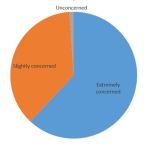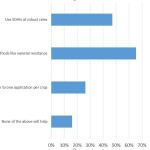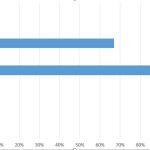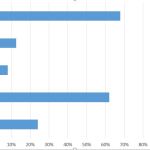Download article

A survey carried out by CPM and Bayer has revealed that recent findings on septoria, and warnings of resistance haven’t gone unnoticed, but views differ on action. CPM analyses the results.
If you use an SDHI-only approach and they struggle this year you would be horribly exposed.
By Tom Allen-Stevens
There’s a high level of awareness among UK wheat growers of the current tenuous situation with septoria and the need to preserve the efficacy of SDHI chemistry. But views differ on the best approach with azoles, while growers are finding it a challenge to plan a strategy that maintains defences while taking account of lower crop returns.
Just over half of respondents to a CPM/Bayer survey on septoria reckon pressure from the disease is likely to increase and remain their key challenge (see below). Almost two thirds are extremely concerned about the threat of resistance to SDHIs developing, while almost three quarters identify a robust dose of azoles as important, particularly as strains with reduced sensitivity to SDHIs have been found.
Level of awareness
“I’m impressed by the high level of awareness about the disease this survey has shown, as well as the losses it causes and growers’ awareness of SDHI resistance as a risk,” comments Dr Fiona Burnett, who chairs the UK Fungicide Resistance Action Group (FRAG-UK).
“They have a good handle on the importance of azoles in the programme – 71% saying it remains important to keep doses up and only 7% saying they were less important is reassuring.”
Bayer’s Tim Nicholson says the discovery of a resistant septoria mutation at very low frequency in isolated locations last year is a ‘warning shot’ for all to look after the chemistry. “SDHIs are a relatively moderate to high-risk chemistry group. When we developed Aviator Xpro, the lesson we learned from strobilurin chemistry was very much part of our thinking. It’s no coincidence that at the minimum rate of 1 l/ha it delivers 160g/ha (80%) of prothioconazole (PTZ),” he notes.
In terms of what growers plan to do to help preserve SDHI efficacy, around two thirds opt for cultural control methods, such as varietal resistance, to reduce the reliance on the chemistry.
“A move towards more resistant varieties will undoubtedly help,” he continues. “A wheat with a decent septoria score allows you leeway in your fungicide programme for the inevitable missed timings, or if the weather goes against you. Even resistant varieties show a good return on investment for fungicide treatment, though.
“But using SDHIs at robust rates is not the best way to overcome selection pressure – 47% of growers appear to favour this. This is a route I’d advise against, as it could have the opposite effect,” warns Tim Nicholson.
In spite of the resolve to keep azole rates robust, 59% of growers are looking to spend less on their fungicide programme (see below). “Growers seem to understand the risk, but equally are concerned about the economics of wheat production,” he says.
Of those who intend to cut costs, most don’t yet know how, notes Fiona Burnett. “Only about a third of growers had any idea how they might do so. Of these the answers were quite sensible – most are going to maintain their early protective spend and try and react to disease pressure late in the season, which is a reasonable aspiration.”
This is reflected in where growers plan to use an SDHI – while 86% will use the chemistry at the T2 timing, two thirds plan to apply one at T1. “One size won’t fit all,” she notes. “But where the risk is high (such as a weak variety or high risk region) then two SDHIs is a fair plan. If we let septoria get well established and try to work eradicantly, we’ll struggle.”
Tim Nicholson agrees, but sounds a note of caution where a focus on keeping cost of production down could compromise disease-control programmes. “Crops will require an appropriate investment, which in most cases is a four-spray programme with sensible rates.” His preferred strategy with an eye on potential cost saving is:
- T0 – where there’s no rust susceptibility, a straight chlorothalonil (CTL) may be possible.
- T1 – if a variety has a septoria rating of 6, particularly in drier parts of the country, then it may be possible to save an SDHI using an azole plus CTL approach but it needs PTZ as the strongest septoria azole that also has stem-base activity. Correct timing is crucial, however, and identifying final leaf three emerged can be challenging.
- T2 – an SDHI is recommended in all crops for both disease control and physiological reasons. Importantly, the azole rate should be included at a minimum 75% rate for both efficacy and resistance management. This should be applied as the flag leaf is just fully emerged as delayed application may require higher rates.
- T3 – reserve some spend for this timing and PTZ should be a key ingredient. Saving cost with less effective chemistry can increase cost per tonne due to compromised yields and quality, especially if it turns wet in June.
SDHI mixture partners were addressed in the survey (see below), with more than half of growers saying they were planning to apply an azole plus a multi-site at both T1 and T2. “That’s sensible,” comments Fiona Burnett.
“Multi-sites are low risk actives that can help reduce pressure on the azoles and SDHIs. The only worry is the amount of CTL that might get used nationally if pesticide statistics were to come under scrutiny.”
Shield the leaf
Tim Nicholson reckons they’re a must at the T0 timing and recommends them with Aviator at T1 if the application is well timed. “But at T2, protectant multi-sites formulated to form a shield on the leaf aren’t conducive to the activity of systemic products designed to get inside the leaf,” he maintains.
“Multi-sites at T2 play a lottery with leaf two. This may have emerged 14 days before the T2 timing, and there’s a good chance of latent septoria and/or rust that will require maximum eradicant activity from a fungicide.”
Both experts have concern for the 12% of growers who propose to use straight SDHIs without an azole partner. “This is worrying, but may be a true reflection of intentions,” says Tim Nicholson.
“Azoles are the only fungicides with eradicant activity other than SDHIs, so only azoles can give resistance management to SDHIs against latent infection.”
Fiona Burnett agrees. “To do this would be risky in terms of stewardship for all of us but would also be a personal high risk strategy. None of us know quite how recent findings will play out, and if you use an SDHI-only approach and they struggle this year you would be horribly exposed.”
However, she also has concerns about how growers view the azoles. Epoxiconazole (EPX) and PTZ are seen as the preferred partner options by 60-70% of growers. “But to put tebuconazole, prochloraz and metconazole all in the same bracket for efficacy overestimates tebuconazole and prochloraz and underestimates the value of metconazole.
“No matter how much of a full dose of a poor azole you use, it won’t be adequately supporting the SDHI as they just don’t have the efficacy – 25% of growers choosing tebuconazole is a worry.”
Growers and agronomists concerned about over reliance on EPX and PTZ could use more metconazole, she suggests. “But broadly these three select for similar azole mutations, so alternating will be very subtle in terms of septoria management. There is the opportunity to use others where rust is the problem and give these ones a break, but not as SDHI partners.”
Tim Nicholson agrees that EPX and PTZ are the best azole partners at the two main spray timings. “Tebuconazole or cyproconazole may have a role at T0, and mixed or stacked with a primary azole at the key timings, they do contribute to control.”
Lincs-based agronomist Sean Sparling has concerns for how EPX and PTZ are perceived and how that’s then transferred into spray programmes. “In curative situations they may offer little when compared to an SDHI but are the only options we have. However, as protectants they’re still effective,” he says.
“Until a new mode of action arrives we’ll be relying on azoles as the base for disease control. So if we are to protect SDHIs, they need to be supported by the most effective partners, and currently that’s EPX and PTZ. Equally, we must steward azoles too. If either partner is over exposed it’ll accelerate the speed of resistance developing in the field.”
For the primary azole, Sean Sparling reckons PTZ has the edge on septoria but where rust is the main concern he favours EPX, “although there isn’t a great deal between them either way.
Isolate control
“Adding tebuconazole, metconazole or prochloraz can broaden isolate control but is the additional expense justified? I certainly wouldn’t want to see primary azole rates cut to accommodate such strategies. Robust rates of a primary azole plus SDHI with or without CTL are still giving good septoria protection.”
Strobilurins offer some kick-back on rust, he adds. “My programmes will start with CTL at the T0 timing and could see further doses at the T1 and T2, but we need to be aware of any antagonism in curative situations, particularly with yellow rust.”
Using just an azole plus CTL still has a place, notes Sean Sparling. “A later sown, resistant variety might not need the potency of an SDHI at the T1. It’ll help reduce the selection pressure on the chemistry.”
High septoria pressure leads to strategy shift
An integrated approach is the only way to stay on top of disease according to Dorset farm manager Tim Hall.
He looks after 343ha of winter wheat across two farms in what might be considered one of the most septoria-prone areas in the country. Just 20 miles from the coast, a minimum of 1000mm of rain isn’t unusual for most years, piling on the disease pressure. In the last septoria epidemic of 2014, where his programme was compromised by the weather, he had some crops where the disease was highly visible on the flag leaf by mid-flowering and leaf two was almost devoid of green leaf area.
In response he’s moved to more resistant varieties, applies a T0 as standard in foliar programmes and has done a re-think on seed rates and drilling date.
For varieties Tim Hall looks for a minimum septoria score of 6, although he does still grow JB Diego as it’s been his top and most consistent performer in four of the past six seasons, and it can attract the odd premium. “Performance is still a driver in variety choices but more and more I’m being steered towards varieties such as KWS Lili, Revelation and Reflection to help beat disease,” he says.
But he’s also pushed back the drilling date to late Sept and reduced seed rates in some situations. “Part of the problem is the way septoria spreads over the plant, especially when fuelled by mild winters. It’s not just the fact that these softer crops aid leaf transfer, they also lead to the development of more humid conditions in the canopy.
“This microclimate is just piling up the pressure as the leaves remain wetter for longer. There can be a penalty of reducing seed numbers if we have a dry spring, but grain sites often compensate if we don’t quite get the target tillers we’re hoping for. Besides, a reduction in tillers isn’t as damaging as septoria getting established,” he suggests.
The other shift is for foliar programmes to start with a T0, something which he now sees as essential. “In the past our T0 thinking was more about checking rusts. Now our aim is to get 500g/l of chlorothalonil (CTL) on the crop to keep the final four leaves clean for as long as possible. All too often crops are coming through the winter with plenty of potential but plenty of septoria too,” he notes.
The other programme change is that SDHIs often feature twice, although he insists an azole plus CTL still has a place at the T1. “If it turns dry then azole and CTL is still an option if high rates and good timing are adhered too. However, where the pressure is high then you really need the extra potency of the new chemistry.”
SDHI choices swing on Adexar (epoxiconazole+ fluxapyroxad) and AviatorXpro (prothioconazole+ bixafen) although Tim Hall also likes the flexibility that straights offer. “It really depends on getting the necessary septoria protection at the best price. A full rate of Adexar delivers the optimum loading of SDHI for curative situations but Aviator has the benefit of being supported by the more potent septoria azole. Aviator also has the edge on rainfastness, and we’ve used it right up until the rain starts to fall!”
With a reliance on SDHIs it means stewardship is vital in his opinion. With few new actives coming to the market, he’s concerned what this means for septoria control in the future and highlights the need to steward both SDHIs and azoles. “Azoles are essential to help reduce the pressure on SDHIs. Regardless of what SDHI I opt for, I always ensure it’s used at a rate that delivers at least a three-quarter azole dose. Using multi-site protectants like CTL, especially in the more protective phase of the programme, is also key in managing resistance.
“We saw in strobs how quickly resistance can develop for single-site activity products, and low doses of both strobs and azoles just hastened their demise. That’s what plays on the mind when deciding foliar strategies,” he notes
- What is your view of disease pressure?
- Is the threat of resistance developing to SDHI fungicides a concern?
- Is a robust dose of azole important in supporting the SDHIs against resistance?
- What will you do to help preserve SDHI efficacy?
- Where will you make savings on fungicides?
- Where do you expect to use an SDHI?
- What SDHI mixture partner will you use at the T1 and T2 timings?
- Which are your preferred azole partners?












